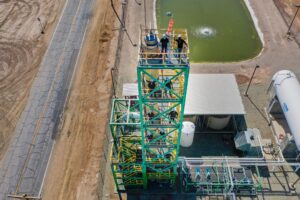Honeywell UOP (Des Plaines, Ill.; www.honeywell.com/uop) recently began offering a post-combustion carbon-capture system based on new advanced solvent technology that allows for improved carbon-capture economics for hard-to-abate industries, such as steelmaking, rotary kiln operations (such as cement-making) and natural-gas power production. The advanced solvent technology has been licensed by Honeywell UOP from the University of Texas at Austin (www.utexas.edu), where the technology was developed at the Texas Carbon Management Program, led by chemical engineering professor Gary Rochelle.

Source: Honeywell UOP
The proprietary amine solvent developed by Rochelle’s group has two distinct advantages over conventional amine solvents used to capture CO2 from fluegas. First, it absorbs CO2 more quickly than other current-generation solvents, allowing for a shorter absorber for the capture phase, which saves capital costs. Second, the solvent is more thermally stable, so the stripper (for solvent recovery and CO2 collection) can be operated at higher temperatures and pressures. This lowers the energy requirements for compressing the captured CO2, explains Rochelle. Beyond the solvent, the advanced carbon-capture system has an enhanced heat-recovery system that allows improved utilization of heat energy. Taken together, the system has improved process economics for carbon capture, making it more viable for CO2 abatement at industrial facilities.
The commercially available technology works at a wide range of CO2 concentrations, but 4–20% CO2 in fluegas is the projected operating range, Rochelle says, and it is available for installation at new facilities or to be retrofitted onto existing ones. Ben Owens, vice president and general manager, Honeywell Sustainable Technology Solutions, says the company has begun dialogues with several potential customers, but has not yet announced the first CO2-capture project using the advanced solvent technology.